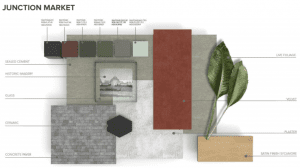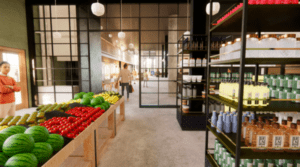Designing for a Post-Pandemic World
March 1, 2021Material solutions leader 3M teamed up with CCS students on the “Detroit Spaces” project to re-envision public spaces and the next phase of working, and gathering, together.
The most asked question during the pandemic has been, “When will life get back to normal?” It’s a question without any satisfying answers. What we do know is that shared office spaces and storefront retail have declined dramatically, while telecommuting, online shopping and “safer” public gathering have skyrocketed. The fundamental role of designers is to create public spaces that adapt to evolving human needs and point toward new possibilities.

Rebecca Bonner
During the Fall 2020 semester, material solutions leader 3M partnered with CCS’s MFA Color & Materials Design students and undergraduate Interior Design students, challenging them to re-envision commercial and public spaces — from retail and offices to communal spaces — in a post-pandemic world.
Led by Interior Design Chair Sandra Olave, Color & Materials Design Chair Sally Erickson Wilson, and Adjunct Instructor Dikea Katakis (’02 Interior Design), and sponsored by Kevin Gilboe, Head of Design, International at 3M, the interdisciplinary studio, “Detroit Spaces,” asked students to consider not only what these new spaces might look like but how they might function. What role do such concerns as safety and sustainability play? And, how might these innovations have a positive impact on the City of Detroit?
The students were divided into seven teams to research Detroit’s commercial and public spaces and develop their ideas, which ranged from multi-use retail, entertainment and living spaces to open-air retreats.
“Students conducted a deep-dive into the user journey of the spaces they created,” said Erickson Wilson. “What really impressed me was the passion the students held for building opportunities in Detroit, improved access for a range of services and experiences, for example, more markets or services that can be enjoyed on foot, or by bicycle as well as by cars. Access to parks and places to enjoy retail, music and coffee outside or in hybrid workspaces were also explored.”

Olave emphasized that, because student designers had themselves transitioned to digital spaces in order to develop the projects, they also grappled with the inevitable existential questions brought on by the pandemic, such as the loss of tactile experiences and the potential for feelings of depression and isolation. These concerns showed up as more thoughtful, deeply felt and human-centered designs.
“The idea of health and wellness was palpable throughout the project,” Olave said, “and the need to find balance and where we might find that balance in a city. How do we find connection, through these spaces, with nature?”
The standout design was created by Erica Schumacker and Gigi Lin, both first-year Color & Material Design students; Rachel Demchuk, a senior in Interior Design, and Alexis Chase, an Interior Design junior. “The Belle Isle Boardwalk” aims to transform the neglected area around the state park’s zoo into a multi-use entertainment boardwalk using recycled shipping containers.
The design concept resurrects and rehabilitates a historic area while providing a safe, open-air space for Detroit residents to interact with nature and each other.
“The ‘Detroit Spaces’ project has become a growing inspiration for students, my colleagues at 3M and the broader community,” Gilboe explained. “As the best projects always do, it asks a simple but profound question: how might we create a positive impact by working together, with everything we can offer each other? Collaboration is key to success in design.”
